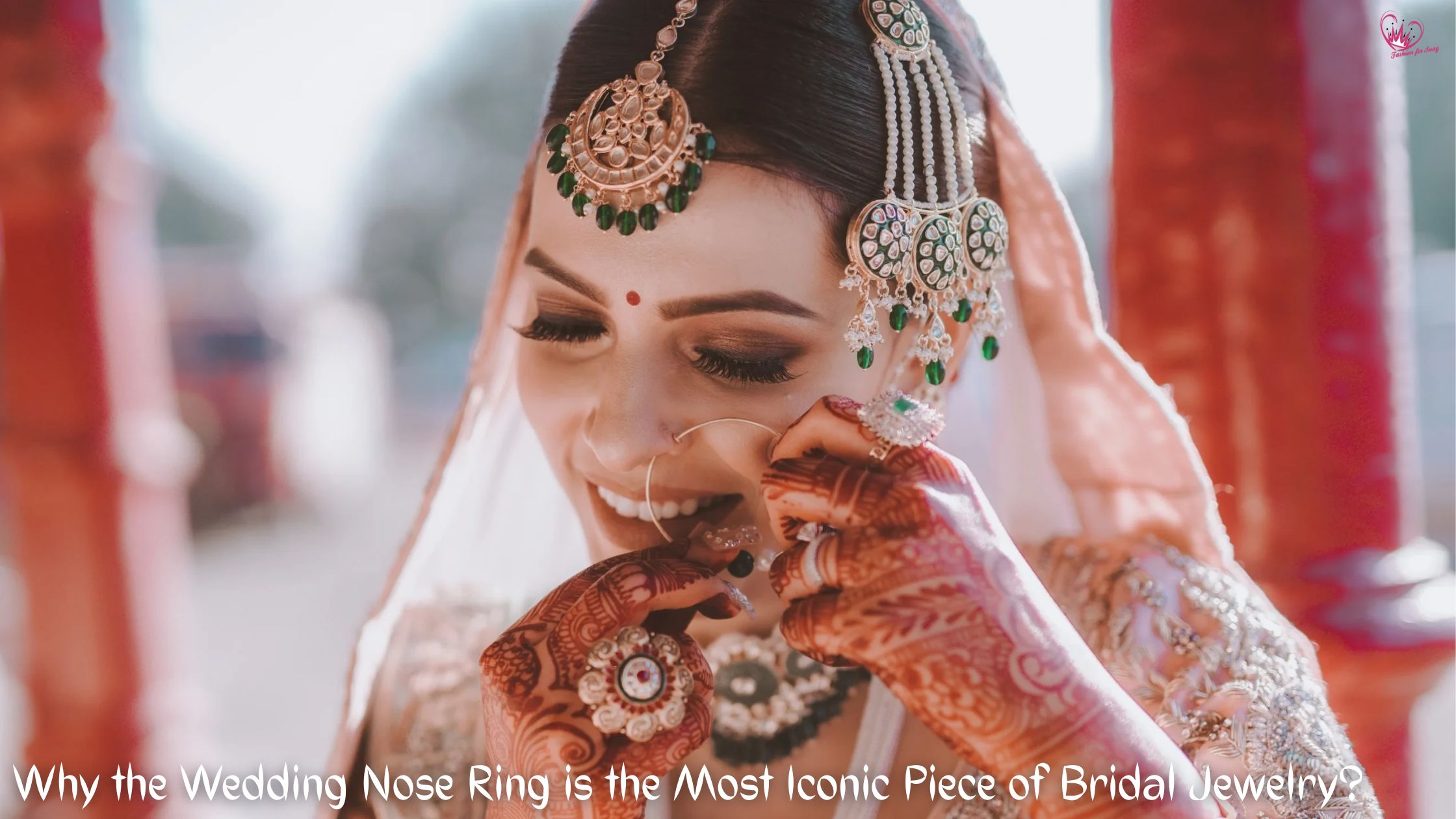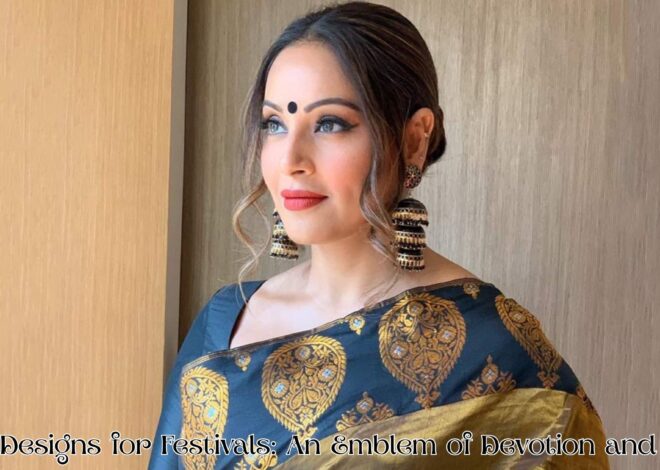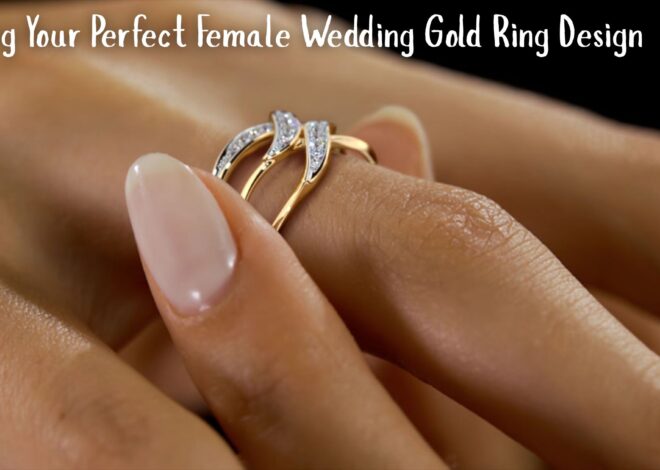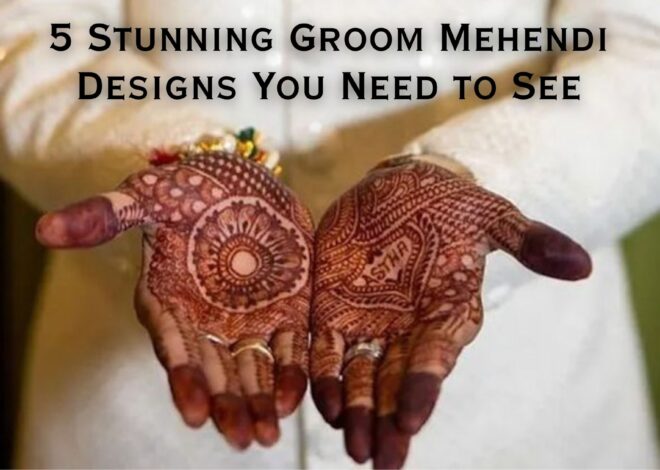
Why the Wedding Nose Ring is the Most Iconic Piece of Bridal Jewelry?
The world of bridal jewelry is vast and dazzling, filled with weighty gold necklaces, sparkling diamond tiaras and delicate anklets. Yet, there is one piece of jewelry that commands attention, that instantly transforms a woman into a bride, and holds centuries of tradition and symbolism in its delicate twist: the wedding nose ring, or Nath.
The nose ring is more of a symbol than just an accessory. It is a stunning, often oversized, piece of art that frames the face, draws the eye, and serves as a singular, defining element of the bride’s look. Its power lies not only in its visual splendor, but also in its profound cultural, historical and physical significance.
This piece will explore the multifaceted reasons why the wedding nose ring – a small piece of metal worn on the face – is the most iconic and emotionally resonant piece of bridal jewelry, surpassing even the wedding ring and Mangal sutra in the visual declaration of marriage.
The Power of Placement: A Statement on the Face
The primary reason why nose rings are so coveted is because of its unforgettable location. Unlike earrings hidden by the hair, necklaces hidden under the veil, or bangles hidden by clothing, the nose ring sits at the very centre of the face, demanding direct engagement.
The Focal Point of Bridal Glamour
The face is the canvas in bridal fashion. Every element – from the carefully crafted makeup to the intricate maang tikka (forehead jewellery) – is designed to draw attention to the bride’s eyes and expressions. Nath acts as the final focal point that establishes this entire aesthetic.
- Light and Shadow: The circular design of the nose ring creates movement. Its hanging beads, stones, or chains (shikhara) catch the light, creating a natural glow and play of shadow that highlights the cheekbones and jawline, contributing to the ethereal bridal aura.
- The gracefulness of the chain: The pearl fringe (pearl or gold chain) that connects the ring to the hair or ear is important. It visually frames the profile, creating a graceful, downwards-moving line that adds an element of majestic elegance and royalty. This series ensures that the nose ring is not just a face piercing, but a comprehensive piece of jewelry that matches with the overall bridal hairstyle and headpiece.
The Visual Declaration of Status
The sheer size and complexity of a traditional wedding nose ring – often a hoop several inches in diameter decorated with multiple layers of work – makes it an instant, unmistakable symbol of the bride. It is a piece of jewelry that is rarely, if ever, worn in such an elaborate manner outside a wedding ceremony. This is the visual semaphore that screams: I am the bride.
- Quick Transformation: A woman may wear all other traditional jewellery, but the transformation for the bride is not complete until the Nath is installed. Its appearance marks the final, most impressive stage of the bride’s makeup ritual.
Deep Historical and Cultural Resonance
The iconic status of the nose ring is deeply rooted in centuries of history, particularly in the cultures of the Indian subcontinent, where it originated as a wedding staple.
The Middle Eastern Migration Theory
While the practice of nose piercing is ancient, it is widely believed that the nose ring, especially in the left nostril, was brought to India from the Middle East during the Mughal period (16th century). Its initial spread was more prevalent in northern India, eventually becoming a pan-Indian and then global phenomenon. This history gives Nath a fascinating cross-cultural heritage, symbolizing centuries of trade, migration and cultural fusion.
A Mark of Matrimony and Auspiciousness
In many Hindu traditions, the nose ring is the most powerful identifier of a married woman, second only to the mangalsutra or toe rings.
- Ritual of exchange: Historically, nose rings were not just worn; It was often presented by the groom’s family, symbolizing their acceptance of the bride and her entry into their lineage. The act of wearing the nose ring represents the moment when a woman gave up her single identity and embraced her new role as a wife.
- Removal on the wedding night: In some communities, the removal of the nose ring by the groom on the wedding night is a sacred, intimate ritual. This act marks the culmination of the marriage ceremony and the final, private acceptance of the bride by her husband. This ritual significance elevates the nose ring far beyond mere decoration.
Regional Icons: The Nath Across India
The iconic status of the nose ring is reinforced by the wide variety of its regional forms, each of which is instantly recognizable and culturally significant:
| Region | Name/Style | Key Features | Iconic Significance |
| Maharashtra | Peshwai/Marathi Nath | Distinctive cashew-shaped design, often studded with pearls, rubies, or emeralds. No chain. | Symbolizes the elegant, royal aesthetic of the Maratha Empire. Instantly recognizable cultural marker. |
| North India | Kumaoni/Garhwali Nath | Extremely large hoop (6-10 inches) connected by a heavy, elaborate chain. Gold and detailed filigree work. | Represents the pinnacle of bridal statement jewelry; the largest and most dramatic form. |
| South India | Mookuthi | Smaller, diamond or stone-studded stud on the right nostril or septum ring. | Focuses on precision and fine craftsmanship, a subtle but persistent symbol of wedded life. |
| Rajasthan | Nathni | Large, ornate hoop, often featuring meenakari (enamel work) and connected to the hair. | Reflects the state’s rich, colorful, and highly decorative royal heritage. |
This cultural and aesthetic diversity ensures that the “wedding nose ring” is not a concept, but a rich tapestry of iconic regional announcements.
The Mystical and Health Connections (Ayurveda)
The enduring tradition of the nose ring is often linked to ancient Indian medical practices, particularly Ayurveda, which links jewelery with symbolic connections to health and fertility.
The Left Nostril Connection
In traditional Indian cultures, nose piercing is almost exclusively done on the left nostril. This is not arbitrary. According to Ayurvedic philosophy, piercing on the left side of the nose is associated with the female reproductive system.
- Ease of delivery: The veins emerging from the left nostril are believed to be connected to the uterus and reproductive organs. Traditionally it is believed that piercing this point reduces the pain during menstruation and childbirth.
- Balancing Feminine Energy: The left side of the body is often associated with feminine, lunar energy (Ida Nadi). By adorning this point, the nose ring is believed to help balance emotional and reproductive health, emphasizing its role in a woman embarking on the journey to marriage and potential motherhood.
Although modern medicine cannot validate these specific associations, the fact that centuries of tradition link the jewelery to the bride’s health, fertility and marital future rapidly increases its iconic status. It has transcended pure aesthetics and become part of medical and spiritual importance.
The Aesthetic Contrast and Complement
Aesthetically, wedding nose rings succeed by providing a vital element of contrast and completeness to the bride’s look where other pieces may fail.
The Contrast of Intricacy
Bridal clothes (lehenga, saree) are generally heavy, heavy and richly embroidered. Jewelery like necklaces and earrings often match this heavy, ornate aesthetic.
However, the nose ring provides a moment of delicate, curved contrast against the highly structured background of the face and headpiece. Even when it is large, its design usually resembles a loop or flowing line, breaking up the rigid geometry of other bridal elements. This strategic contrast makes the face softer and more attractive.
The Bridal Finishing Touch
Think of the nose ring as the final, essential piece of a fabulous jigsaw puzzle.
- Completing the Solah Shringar: The 16 adornments (solah shringar) traditionally worn by the bride – covering her from head to toe – end in the facial area. Nath is one of the essential elements that complete the overall look of a decorated bride. Its absence leaves the outfit incomplete, while its presence signals total, traditional readiness for ceremony.
- The moment of the unveiling: Because the nose ring is central and large, it becomes the most noticeable feature when the bride first appears or lifts her veil. It is a major marker that sets the stage for the bride’s entire appearance and is usually the first element captured in close-up photographs.
Modern Resurrection: Fashion, Freedom, and Fusion
In the 21st century, the wedding nose ring has enjoyed a massive resurgence, moving from strict tradition to become a powerful, intentional fashion statement that defines the contemporary bride.
The Choice of Expression
Nowadays brides adopt Nath not because of obligation, but because of their choice. They seek out special designs and wear nose rings as a celebration of their cultural roots, often in a fusion style:
- Minimal nose ring: Modern brides can choose a delicate gold band or a small, single-diamond nose ring, giving a more contemporary aesthetic to tradition.
- Heritage details: In contrast, many brides from the diaspora choose the largest, most traditional nose ring as a powerful, visible connection to their ancestral heritage in a new country.
- Fusion Brides: Even in inter-cultural weddings, the nose ring is often incorporated into non-traditional gowns (like a white dress) to blend the two worlds, demonstrating its uncanny power to bridge cultural gaps. Its iconic look is recognizable enough to indicate “bridal heritage” even when paired with a completely western outfit.
Celebrity Influence and Global Recognition
From Bollywood royalty to international fashion icons, the visibility of elaborate wedding nose rings on famous brides has cemented its place in the global consciousness. Every time a major celebrity chooses an ornate nose ring, it cements its position as the pinnacle of wedding jewelry, and inspires countless others to adopt the tradition. This constant, high-profile presence keeps the wedding nose ring in the top tier of coveted bridal imagination around the world.
Conclusion: The Uncontested Icon
The wedding nose ring, or nath, is the most coveted piece of bridal jewelry as it achieves a perfect, powerful synthesis of form and meaning.
It’s a visual masterpiece whose central location guarantees immediate attention. It is a cultural cornerstone, steeped in centuries of history, regional diversity and wedding customs. It is a physical amulet, linked to ancient beliefs about health and well-being. And finally, it is a modern statement, worn by choice as an expression of heritage and high fashion. No other piece of bridal jewelry – neither a commitment ring nor a wedding necklace – has this unique, layered resonance. The moment a bride wears her nose ring, she is completely transformed, crowning her with the most dramatic, meaningful and lasting symbol of her wedding day. It’s not just jewelry; It’s a profound declaration, hung beautifully right in the middle of the bridal portrait.



